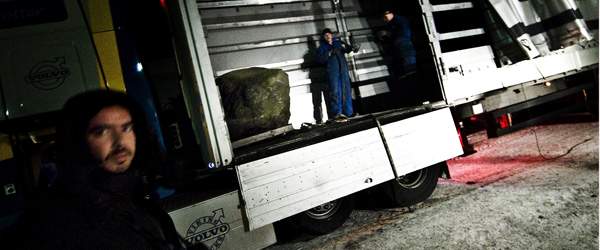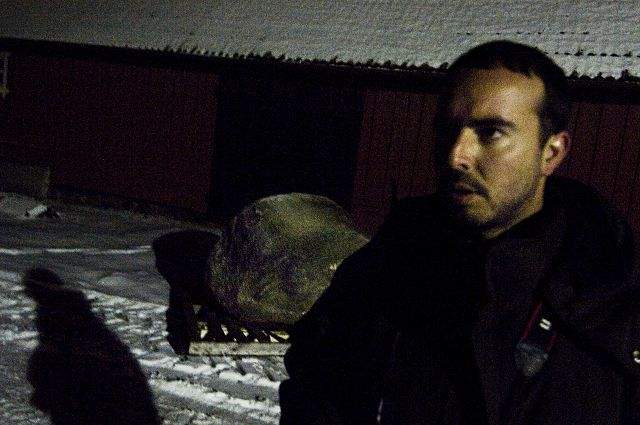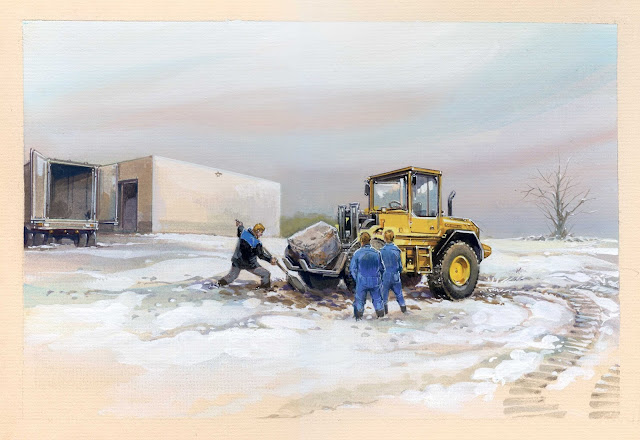Longitudes
Longitudes cuts across Latitudes’ projects and research with news, updates, and reportage.
LaPublika – Public sphere laboratory for artistic research, consonni, Donostia, 10–11 November 2015
Mon, Nov 2 2015"Public sphere here is understood as spaces considered to be public (the street, the square, the city), as well as the internet or the communications media, and the mechanisms with which we participate in managing what is common (language, rites, norms, the aesthetic of collective processes). At a time when new social and civic paradigms are arising, LaPublika seeks to provide a framework of work and reflection upon those processes." (....) "In addition to the presence-based programme, all the activities have their version in podcast format on LaPublika’s radio-web, the central hub of the project, which is also backed up by programming involving interviews, radio spots and sound pieces."
Visitors at Robert Smithson's "Broken Circle" (1971), an event organised by Land Art Contemporary. Picture: Kunstbeeld.
Breaking
Ground: Broken Circle/Spiral Hill, by Robert Smithson & Nancy Holt -
See more at:
http://ajuntament.barcelona.cat/lavirreina/en/activities/breaking-ground-broken-circlespiral-hill-robert-smithson-nancy-holt#sthash.8wxhhHQB.dpuf
Breaking
Ground: Broken Circle/Spiral Hill, by Robert Smithson & Nancy Holt -
See more at:
http://ajuntament.barcelona.cat/lavirreina/en/activities/breaking-ground-broken-circlespiral-hill-robert-smithson-nancy-holt#sthash.8wxhhHQB.dpuf
Breaking
Ground: Broken Circle/Spiral Hill, by Robert Smithson & Nancy Holt -
See more at:
http://ajuntament.barcelona.cat/lavirreina/en/activities/breaking-ground-broken-circlespiral-hill-robert-smithson-nancy-holt#sthash.8wxhhHQB.dpuf
Breaking
Ground: Broken Circle/Spiral Hill, by Robert Smithson & Nancy Holt -
See more at:
http://ajuntament.barcelona.cat/lavirreina/en/activities/breaking-ground-broken-circlespiral-hill-robert-smithson-nancy-holt#sthash.8wxhhHQB.dpuf
Latitudes' workshop titled “Beyond the roundabout, or what’s public about public art?” will take the legacy of Land Art as a starting point – or more specifically, Robert Smithson’s notion of “continual movement” – to address the multiple temporalities which can constitute the form of an artwork in public space. Approaching projects (rather than beholding objects) the workshop will discuss artists who conceptualize or actualize their works against a backdrop of vast stretches of time or topological change. In the context of a networked culture which seems to offer an accelerating and horizontal concept of the public sphere, the workshop will furthermore address what is at stake when “digging deep” and slowing down.
Production of Jan Dibbets' "6 Hours Tide Object with Correction of Perspective" (1969–2009) on 9 February 2009 the Port of Rotterdam, a beach that has now disappeared to become Maasvlakte 2. Photo: Latitudes.
For the public lecture on November 11, Latitudes will forgo a chronological account of its projects of the last decade, and instead attempt various transects through its curatorial projects determined by the public sphere, raw materials and their transformation. From the zinc which led to an Esperanto micro-nation, to the air of a Beijing shopping centre, or the dead trees of printed news, Latitudes will join some traits and ideas around “human resources”, extractive modernity, obsolescence and the carbon cycle.
RELATED CONTENT:
- More about Consonni
- More about LaPublika
- Launch of LaPublika to the basque press
- Video de Latitudes sobre el taller desarrollado en LaPublika.
Looking back – Visiting Robert Smithson's 'Spiral Jetty' (1970) on 7 September 2004
Sun, Sep 7 2014
A decade ago today (!) we were lucky enough to visit Robert Smithson's most iconic earthwork 'Spiral Jetty' (1970). The water level of the Great Salt Lake was well down and the surface of the counterclockwise spiral was not only visible but also walkable. As we walked alone in the blazing heat we felt as if we were disappearing into the black basalt, pink salt and silent haze.
Our visit to the site was completed a few days later visiting his “Retrospective Works 1955-1973” at Los Angeles’ MOCA, curated by Eugenie Tsai with Connie Butler. Happy memories!
Related posts:
- Lecture by Max Andrews "From Spiral to Spime: Robert Smithson, the ecological and the curatorial", 13 March, 2pm, Lecture Theatre 1, Royal College of Art, London (12 March 2012)
- Publication "Robert Smithson: Art in Continual Movement" (Alauda Publications, 2012) includes an essay by Max Andrews (28 March 2012)
- Robert Smithson's 'Broken Circle/Spiral Hill Revisited' (1971–2011) and The Land Art Contemporary programme (14 September 2011)
- Portscapes: Jorge Satorre returns an ice-age boulder back to Sweden (18 January 2010)
–
This is the blog of the independent curatorial office Latitudes. Follow us on Facebook and Twitter.
All photos: Latitudes | www.lttds.org (except when noted otherwise in the photo caption).
This post is licensed under a Creative Commons Attribution-NonCommercial-NoDerivs 3.0 Unported License.
Haegue Yang "Der Öffentlichkeit" commission and 'Ends of the Earth – Land Art to 1974' at Haus der Kunst, Munich
Sun, Nov 11 2012Her installation 'Accommodating the Epic Dispersion – On Non-cathartic Volume of Dispersion', organised by Haus der Kunst curator Julienne Lorz, and related to her dOCUMENTA 13 contribution, "consists of Venetian blinds suspended from the ceiling. These elements are structured in three autonomous, yet united parts: A massive towering structure, which is confrontationally located at the hall's entrance; a flat vertical grid wall, and a voluminous rectangle on top, which is gradually fragmented toward the floor. Depending on the angle of approach, the blinds overlap in a varying number of layers, and the interplay of light and shadow changes depending on the location. At times, the installation appears completely opaque, and at others, completely translucent." (text from the website).
On view until 22 September 2013. More info and photos here.
Also on view at Haus der Kunst is the much awaited 'Ends of the Earth – Land Art to 1974' (until 20 January 2013) organised in collaboration with The Museum of Contemporary Art, Los Angeles (MOCA – see website of the exhibition). The show is notable for its careful and thoroughly-researched reconsideration of the idea of Land art, and the way in which it incorporates many artists outside of the usual American white male practicioners associated with the term. (And also through its inclusion of three part-reconstructions of seminal exhibitions/projects: "Earthworks" at Virginia Dwan Gallery, Willoughby Sharp's "Earth Art" as well as Gerry Schum's "Fernsehgalerie Land Art" ). Unfortunately, this is its only iteration on its European tour.
Exhibition poster with an image of the 1967-74 film "Athmospheres: Duration Performances" by Judy Chicago.
Hans Haacke's "Grass Grows" (1969–2012) at the entrance to the museum.
Robert Smithson's "Spiral Jetty" (1970) film projected in the background and "A Nonsite (Pine Barrens)" from 1968 in the foreground.
Robert Morris' "Earthwork aka Untitled (Dirt)" (1968–2012) a 2000-pound pile of earth, grease, peat moss, brick, steel, copper, aluminum, brass, zinc and felt – urban debris gathered from the surrounding New York environs, originally made for the 1968 exhibition at Virginia Dwan Gallery.
Two views (above and below) of Joshua Neustein's 1970 "Road Piece", originally presented in the Tel Aviv Art Museum and remade for the first time for 'Ends of the Earth' exhibition.
All photos: Latitudes | www.lttds.org (except when noted otherwise in the photo caption)

This work is licensed under a Creative Commons Attribution-NonCommercial-NoDerivs 3.0 Unported License.
"Der Öffentlichkeit – Von den Freunden Haus der Kunst", begins on November 9
More Information: http://www.artdaily.org/index.asp?int_sec=2&int_new=58839#.UJ6Z7YVe6kI[/url]
Copyright © artdaily.org
More Information: http://www.artdaily.org/index.asp?int_sec=2&int_new=58839#.UJ6Z7YVe6kI[/url]
Copyright © artdaily.org
"Der Öffentlichkeit – Von den Freunden Haus der Kunst",
More Information: http://www.artdaily.org/index.asp?int_sec=2&int_new=58839#.UJ6Z7YVe6kI[/url]
Copyright © artdaily.org
More Information: http://www.artdaily.org/index.asp?int_sec=2&int_new=58839#.UJ6Z7YVe6kI[/url]
Copyright © artdaily.org
"Der Öffentlichkeit – Von den Freunden Haus der Kunst",
More Information: http://www.artdaily.org/index.asp?int_sec=2&int_new=58839#.UJ6Z7YVe6kI[/url]
Copyright © artdaily.org
More Information: http://www.artdaily.org/index.asp?int_sec=2&int_new=58839#.UJ6Z7YVe6kI[/url]
Copyright © artdaily.org
"Der Öffentlichkeit – Von den Freunden Haus der Kunst",
More Information: http://www.artdaily.org/index.asp?int_sec=2&int_new=58839#.UJ6Z7YVe6kI[/url]
Copyright © artdaily.org
More Information: http://www.artdaily.org/index.asp?int_sec=2&int_new=58839#.UJ6Z7YVe6kI[/url]
Copyright © artdaily.org
"Der Öffentlichkeit – Von den Freunden Haus der Kunst",
More Information: http://www.artdaily.org/index.asp?int_sec=2&int_new=58839#.UJ6Z7YVe6kI[/url]
Copyright © artdaily.org
More Information: http://www.artdaily.org/index.asp?int_sec=2&int_new=58839#.UJ6Z7YVe6kI[/url]
Copyright © artdaily.org
As announced in May,
this installation is the first in a series of commissioned work that
will be exhibited in the museum's 800 square-meter Middle Hall over a
period of one year. The series, "Der Öffentlichkeit – Von den Freunden
Haus der Kunst", begins on November 9.
More Information: http://www.artdaily.org/index.asp?int_sec=2&int_new=58839#.UJ6Z7YVe6kI[/url]
Copyright © artdaily.org
More Information: http://www.artdaily.org/index.asp?int_sec=2&int_new=58839#.UJ6Z7YVe6kI[/url]
Copyright © artdaily.org
"Accommodating the Epic Dispersion – On Non-cathartic Volume of Dispersion", 2012.
More Information: http://www.artdaily.org/index.asp?int_sec=2&int_new=58839#.UJ6Z7YVe6kI[/url]
Copyright © artdaily.org
More Information: http://www.artdaily.org/index.asp?int_sec=2&int_new=58839#.UJ6Z7YVe6kI[/url]
Copyright © artdaily.org
Publication "Robert Smithson: Art in Continual Movement" (Alauda Publications, 2012) includes essay by Max Andrews
Wed, Mar 28 2012 |
| Cover of the publication. All photos: Latitudes | www.lttds.org |
We just received a copy of the wonderful and long-awaited publication "Robert Smithson: Art in Continual Movement" (Alauda Publications, 2012) for which Max Andrews of Latitudes contributes the essay "A Dark Spot of Exasperation: From Smithson to the Spime" (an essay which was the basis of his recent lecture at the Royal College of Art in London).
Pages 44-45, with the section "Art, Research, Ecology".
Robert Smithson's seminal Land Art work Broken Circle/Spiral Hill (Emmen, The Netherlands, 1971) is treated as a case study that opens up to a
number of topics, still relevant in contemporary art: 'Models of
Spectatorship', 'Art, Research, Ecology', 'Documentation', 'Museum,
Media, Society' and 'The Cinematic'."
Max Andrews' essay "A Dark Spot of Exasperation: From Smithson to the Spime".
In his text, Andrews stresses that Smithson's innovations in terms of post-studio practice are not about "the question where, or what is the work of art?", but about investigating the structure of the multiple elements which constitute the form of an art project and its place in the world. According to Andrews, the essential feature of Smithson's kinship to post-studio practice is not so much his institutional critique, but a move away from the museum and the curator as existing power structures to a "curatorial function which incorporates a social ecology: a new meaning- and value-generating system in and around art." In his essay, Andrews traces the points of congruence between Smithson and the practices of contemporary artists like Lara Almarcegui, Jorge Satorre and Cyprien Gaillard.
Documentation pages, clippings from 1987.
Pages 150-151, Section "A Living Archive – Film"
Page 194-195, Section "A Living Archive"
Pages 208-209, Section "A Living Archive"
The 240-page monograph publication will be launched on 30 March 2012 in The Hague during the symposia Rethinking Robert Smithson organised by the publishers in cooperation with Leiden University Institute for Cultural Disciplines.
Initiator and publisher: Alauda Publications
Edited by: Ingrid Commandeur and Trudy van Riemsdijk-Zandee
Authors: Max Andrews, Eric C.H. de Bruyn, Stefan Heidenreich, Sven Lütticken, Anja Novak, Vivian van Saaze
Design: Esther Krop
ISBN: 9789081531481
Edited by: Ingrid Commandeur and Trudy van Riemsdijk-Zandee
Authors: Max Andrews, Eric C.H. de Bruyn, Stefan Heidenreich, Sven Lütticken, Anja Novak, Vivian van Saaze
Design: Esther Krop
ISBN: 9789081531481
Price: 39,95 Euro
Available in bookshops or order online: alaudapublications.nl
Available in bookshops or order online: alaudapublications.nl
Related links:
- September 2011 blog post on The Land Art Contemporary programme in Denthe, The Netherlands.
Lecture by Max Andrews "From Spiral to Spime: Robert Smithson, the ecological and the curatorial", 13 March, 2pm, Lecture Theatre 1, Royal College of Art, London
Mon, Mar 12 2012
Poster announcement at the Royal College of Art galleries.
On Tuesday 13 March (2pm, Lecture Theatre 1), Max Andrews of Latitudes will give the lecture "From Spiral to Spime: Robert Smithson, the ecological and the curatorial" as part of the "Art and Globalisation" lecture series programmed by MA Curating Contemporary Art by Jean Fisher and Michaela Crimmin.
Starting out from Robert Smithson's Broken Circle / Spiral Hill (1971), this lecture looks at projects by Lara Almarcegui, Jorge Satorre and Cyprien Gaillard to speculate on the 'when' and the 'shape' of art after Smithson in relation to synchronic concepts of post-environmental ecological thinking, and the flux between work and curatorial context. Based on an essay in the forthcoming publication 'Robert Smithson: Art in Continual Movement' (Alauda Publications, 2012).
Following the lecture, Andrews will lead a seminar to first years students of the MA Curating Contemporary Art, Royal College of Art.
[Please note that the lecture is only open to students and college staff.]
Robert Smithson, Broken Circle/Spiral Hill. Opening September 17, 2011. Emmen, The Netherlands. Photo by Jan Anninga. Courtesy SKOR.
Following the lecture, Andrews will lead a seminar to first years students of the MA Curating Contemporary Art, Royal College of Art.
[Please note that the lecture is only open to students and college staff.]
Tuesday 13 March 2012, 2pm
Lecture Theatre 1
Royal College of Art
Kensington Gore
London SW7 2EU, UK
All photos: Latitudes | www.lttds.org (except when noted otherwise in the photo caption)

This work is licensed under a Creative Commons Attribution-NonCommercial-NoDerivs 3.0 Unported License.
All photos: Latitudes | www.lttds.org (except when noted otherwise in the photo caption)

This work is licensed under a Creative Commons Attribution-NonCommercial-NoDerivs 3.0 Unported License.
Robert Smithson's 'Broken Circle/Spiral Hill Revisited' (1971–2011) and The Land Art Contemporary programme
Wed, Sep 14 2011
Land Art Contemporary year-long initiative showcases works of art located in the countryside of Drenthe, a province in the northeastern Netherlands, which will be complemented with an international events programme dealing with the contemporary aspects of Land art. Starting on 17 September 2011, the programme is linked to the 40th anniversary of the creation of Robert Smithson's film Broken Circle/Spiral Hill in Emmen for the exhibition Sonsbeek 1971.
Coinciding with the anniversary, Land Art Contemporary kicks off with the exhibition 'Robert Smithson – Broken Circle/Spiral Hill Revisited', at the Centre for Visual Arts (CBK) in Emmen. The exhibition's star piece will be the recently completed film 'Breaking Ground: Broken Circle/Spiral Hill' (1971–2011), uncompleted due to Smithson's untimely death in 1973, which is now finally produced, following his instructions for direction
and editing, by his widow Nancy Holt in collaboration with SKOR. The film will also be screened once on 22 September at the Stedelijk Museum Amsterdam. Holt will introduce the video.
Parallel to this major exhibition, SKOR is also organising The Ultraperiferic (17 September – 27 November 2011), an exhibition that will feature the work of Lara Almarcegui (ES/NL), Jorge Satorre (MX/NL) and Cyprien Gaillard (FR/DE), three artists with whom Latitudes has worked in the recent past and whose work will also be featured in Max Andrews' essay "A Dark Spot of Exasperation: From Smithson to the Spime" in the forthcoming publication 'Robert Smithson: Art in Continual Movement' (ISBN 9789081531481) by Alauda Publications to be released in early 2012. The essay and The Ultraperiferic both feature Jorge Satorre's 'The erratic. Measuring compensation' (2009) which was produced in the context of 'Portscapes' and recently featured in his exhibition at Labor, Mexico City.
The project will continue in 2012–13, with a series of 'assignments' to contemporary artists "a number of artists will be set the assignment of creating a work in the spirit of Smithson, whereby the landscape is viewed as a continual process that is constantly in a state of transformation due to the interaction between man and nature", to be curated by SKOR's curators Nils van Beek and Theo Tegelaers. + info...
Land Art Contemporary is an initiative of STICHTING LACDA, Drenthe, a foundation established in 2011 by the Sanders-Ten Holte family.
The program has been made possible thanks to (content and financial)
support from SKOR | Foundation for Art and Public Domain, Province of
Drenthe, European Agricultural Fund for Rural Development: Europe
Investing in Rural Areas (LEADER), Municipality of Coevorden,
Municipality of Emmen, Cultuurfonds BNG and the Sanders-Ten Holte
family.
Portscapes: Jorge Satorre returns an ice-age boulder back to Sweden
Mon, Jan 18 2010Jorge Satorre's project for Portscapes had its beginnings in the eastern part of the Netherlands with a 3-tonne gneissic granite rock from the Svecofennian age, approximately 1.9 billion years ago. Following the artist’s fascination with the environmental compensation practices being instigated alongside the construction of Maasvlakte 2, his project consisted of returning the rock to where it once came from in Sweden – an act of synthetic restitution and transnational sculptural offsetting.
The boulder has now found a permanent home at the Wanås Foundation, near Knislinge in southern Sweden [1]. The boulder was transported from Erica, in the northeast of The Netherlands, to Knislinge at the beginning of January (see report on the Swedish newspaper Kristianstadsbladet).
Not insignificantly, the celebrated Land art work 'Broken Circle' (1971) by Robert Smithson, sited in a working quarry near Emmen, incorporates such a seemingly immovable boulder at its centre. Satorre’s reverse geological gesture is also reflected in the fact that much of the existing and future sea defence in the port area will be made from rock brought from Scandinavia. The artist offers an account of the process through drawings, which incorporates both actual and imagined details. One such detail depicts an imagined protest at the beginning of the boulder’s homeward journey – see post 2 October 2009.
Jorge Satorre's project was produced in the context of 'Portscapes', an accumulative series of newly commissioned projects produced in the context of the 2,000-hectare extension to the Port of Rotterdam, the project Maasvlakte 2.
An exhibition with 'Portscapes' projects will be on view at the Museum Boijmans van Beuningen, Rotterdam between 30 January and 25 April 2010 (Reception: Friday 5 February, 20h).
Portscapes was commissioned by the Port of Rotterdam Authority with advice and support from SKOR (Foundation Art and Public Space, Amsterdam) and was curated by Latitudes.
[FOOTNOTE 1] The foundation estate encompasses a medieval castle, an organic farm, and a sculpture park which since 1987 has hosted a number of permanent works by international artists.
Images: Journey and placement of the boulder from the newspaper Kristianstadsbladet; Drawings of 'The Erratic. Measuring Compensation' (2009), courtesy of the artist.























































